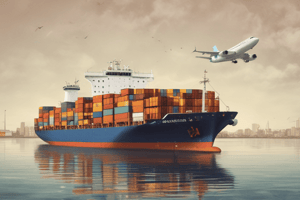Podcast
Questions and Answers
What is the primary purpose of a customs tariff or duty?
What is the primary purpose of a customs tariff or duty?
- To promote free trade and open markets
- To protect domestic industries from foreign competition
- To generate revenue for the government (correct)
- To control the flow of illegal goods across borders
Which of the following best describes the concept of a 'customs schedule'?
Which of the following best describes the concept of a 'customs schedule'?
- The process of calculating the total amount of customs duties owed
- A system for tracking the movement of goods through customs
- A list of imported goods and their corresponding tariff rates (correct)
- A schedule of events for customs officials to follow
Which of the following is a potential negative consequence of high customs tariffs or duties?
Which of the following is a potential negative consequence of high customs tariffs or duties?
- Improved domestic job market
- Stronger national security
- Increased government revenue
- Reduced consumer choice (correct)
What is the primary economic rationale for the imposition of customs tariffs or duties?
What is the primary economic rationale for the imposition of customs tariffs or duties?
Which of the following is a key function of a customs authority or agency?
Which of the following is a key function of a customs authority or agency?
What is the primary purpose of a customs union, such as the European Union?
What is the primary purpose of a customs union, such as the European Union?
Which objective first led to the levying of customs duties for revenue purposes?
Which objective first led to the levying of customs duties for revenue purposes?
Why did import prohibitions gradually decline from about 1750 to 1850?
Why did import prohibitions gradually decline from about 1750 to 1850?
During the World War and the subsequent reconstruction period, what form did tariffs take?
During the World War and the subsequent reconstruction period, what form did tariffs take?
What was the primary reason for the return of import prohibitions during the World War and the subsequent reconstruction period?
What was the primary reason for the return of import prohibitions during the World War and the subsequent reconstruction period?
In what period did import prohibitions largely vanish before the World War?
In what period did import prohibitions largely vanish before the World War?
What was the dominant reason for utilizing export duties in tropical and subtropical countries?
What was the dominant reason for utilizing export duties in tropical and subtropical countries?
What was the primary purpose of establishing different tariff rates based on the origin of goods and ships?
What was the primary purpose of establishing different tariff rates based on the origin of goods and ships?
According to the passage, what is the fundamental characteristic of a tariff?
According to the passage, what is the fundamental characteristic of a tariff?
Which of the following statements best describes the purpose of a customs tariff?
Which of the following statements best describes the purpose of a customs tariff?
Based on the information provided, which of the following rates would be the highest for importing foreign goods?
Based on the information provided, which of the following rates would be the highest for importing foreign goods?
What is the primary function of a tariff board or customs authority?
What is the primary function of a tariff board or customs authority?
According to the passage, what is the primary factor that determines the tariff rate for a particular good?
According to the passage, what is the primary factor that determines the tariff rate for a particular good?
Flashcards are hidden until you start studying
Study Notes
Customs
- A list or schedule of articles or merchandise with the rate of duty to be paid to the Government for their importation or exportation
- A duty levied according to such a schedule or collectively on one class of articles
- The system of imposing duties or taxes on the importation of foreign merchandise
- Originated from duties paid from time immemorial, now considered public taxes on goods crossing the border of a territory
History of Customs
- Initially, duties were only for revenue purposes
- With the growth of mercantilism and nationalism in the 16th and 17th centuries, duties were used to protect domestic industries, promote a favorable balance of trade, and punish foreign countries
- Export duties were abolished, and tariffs came to consist mainly of import duties, except in tropical and subtropical countries
Objectives of Levying Customs Duties
- To increase revenue
- To protect the agriculture and arts of the islands
- To expand foreign commerce
Rate of Customs Duties
- 4 rates were established according to origin:
- Spanish goods in Spanish ships (lowest rate)
- Spanish goods in foreign ships
- Foreign goods in Spanish ships
- Foreign goods in foreign ships
Tariff
- A table or catalog containing the names of several kinds of merchandise with the duties or customs to be paid
- A schedule or rates of import or export duties
- A tax levied on a commodity when it crosses the boundary of a customs area
- Can be a cartel of commerce, a book of rates, or a table or catalogue
Studying That Suits You
Use AI to generate personalized quizzes and flashcards to suit your learning preferences.





